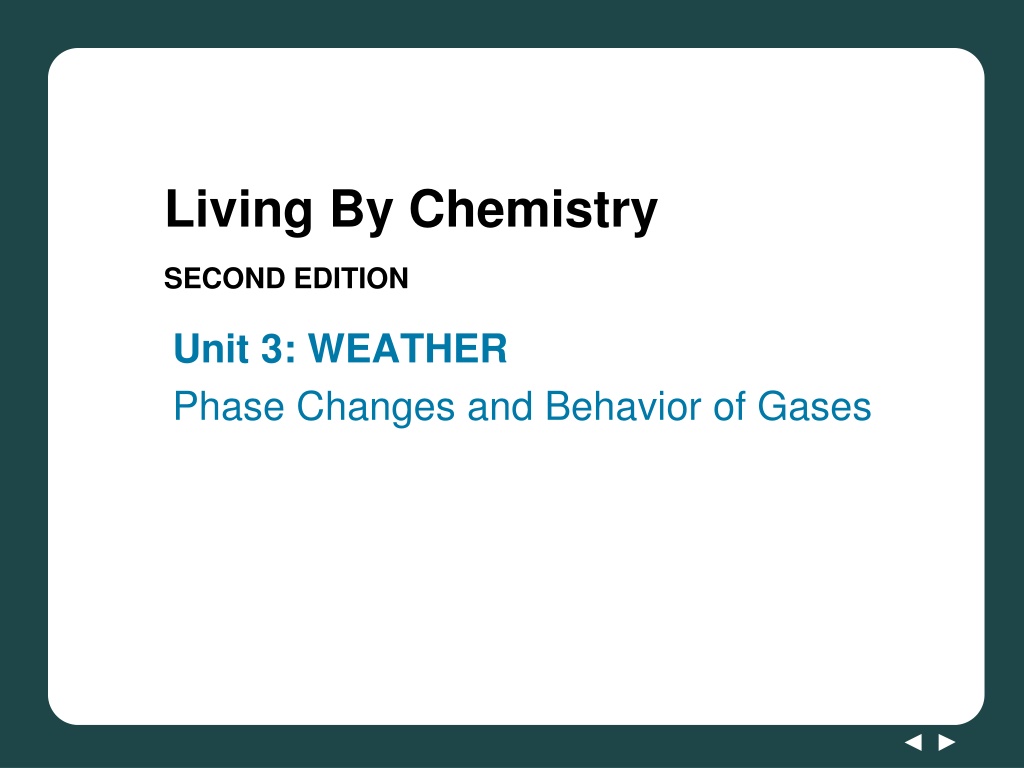Understanding Gas Laws and Phase Changes in Chemistry
Explore the relationships between gas pressure, volume, and temperature through concepts like Gay-Lussac's Law and the behavior of gases in flexible and rigid containers. Gain insights into predicting gas behavior when variables change using the three gas laws: Charles's Law, Boyle's Law, and Gay-Lussac's Law.
Download Presentation

Please find below an Image/Link to download the presentation.
The content on the website is provided AS IS for your information and personal use only. It may not be sold, licensed, or shared on other websites without obtaining consent from the author. Download presentation by click this link. If you encounter any issues during the download, it is possible that the publisher has removed the file from their server.
E N D
Presentation Transcript
Living By Chemistry SECOND EDITION Unit 3: WEATHER Phase Changes and Behavior of Gases
Lesson 59: Egg in a Bottle Gay-Lussac s Law
ChemCatalyst Examine the egg and bottle setup. How could you use gas pressure to get the egg into the bottle? What variables would you change: pressure, volume, and/or temperature?
Key Question How does gas pressure change in flexible and in rigid containers?
You will be able to: describe the qualitative and quantitative relationships between the pressure and temperature of a gas explain how flexible and rigid containers affect the pressure, volume, and temperature of a gas sample complete gas law problems involving changes in pressure
Prepare for the Demonstration Work individually.
Discussion Notes As the gas inside the flask cools, the pressure of the gas inside the flask decreases.
Discussion Notes (cont.) Gas pressure is proportional to temperature if the volume and amount of gas are not changed and if the temperature is expressed in kelvins. Gay-Lussac s law: The pressure of a given amount of gas is directly proportional to temperature if the gas volume and amount of gas do not change and if the temperature is expressed in kelvins.
Discussion Notes (cont.) The three gas laws help predict gas temperature, pressure, and volume when two of these variables change and the third remains fixed.
Discussion Notes (cont.) Flexible container: When the gas is in a flexible container, changing the temperature or the pressure causes the volume to change. Charles s law applies when volume and temperature vary but pressure does not change. Boyle s law applies when volume and pressure vary but temperature does not change.
Discussion Notes (cont.) Rigid container: When a gas is in a rigid container, increasing the temperature causes the pressure to increase. Gay-Lussac s law applies when the pressure and temperature vary but volume does not change. It is important to notice that in all these cases gas cannot enter or escape the containers.
Wrap Up How does gas pressure change in flexible and in rigid containers? The relationship between gas pressure and temperature is expressed in the equation P = kT and is called Gay-Lussac s law. When a gas sample is in a rigid container, its volume cannot change. When a gas sample is in a flexible container, its volume can change. In most containers, the temperature of the trapped gas changes to match the temperature of the gas on the outside.
Wrap Up (cont.) In flexible containers, the pressure of the gas on the inside changes to match the pressure of the air on the outside.
Check-In In the factory, a potato chip bag is filled with 50.0 mL of air. The pressure of the air is 1.0 atm, and the temperature is 25 C. Imagine that you take the potato chips with you on an airplane. At higher altitudes, the air pressure in the cabin is 0.85 atm, and the temperature is 25 C. The potato chip bag puffs up. 1. Which gas law applies? 2. Explain why the potato chip bag puffs up in the airplane. 3. What is the volume of the gas in the potato chip bag when it is at a higher altitude? Show your work.

 undefined
undefined
































